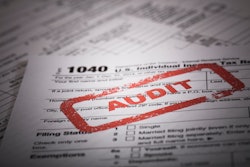Filing taxes for your LLC as an S Corp allows an owner-operator to designate him- or herself as an employee of the LLC yet to still report the income of the business on their personal tax return. S Corp earnings are not subject to self-employment tax, so potential for significant savings exists. Owner-operators can set their driver salary, subject to employment taxes, at whatever level they like, but compensation must be considered “reasonable” or it immediately will be a red flag to the IRS and potentially trigger an audit.
A good rule of thumb used by advisers at ATBS is to think about setting up an S Corp when net earnings consistently begin to exceed $80,000 yearly. At that point, tax savings will be greater than the costs to set up and run the corporation.
An owner-operator whose earned income is projected to stay above that level, even with just one truck, can change the business to an LLC and elect to file as an S Corp. If you do make the switch, be sure to know your responsibilities for filing.
To file as an S Corp and reap tax savings, you will need to treat yourself as a W2 employee of your own business, and you’ll need an Employer Identification Number assigned to the business by the Internal Revenue Service. There’s no fee for obtaining an EIN, though the filing process could take up to a couple weeks before the EIN can be used, according to the IRS.

IRS Form 2553 is then filed to declare intent with the IRS for your LLC to be taxed as an S Corp. ATBS recommends that, if you’re going to go the S Corp route, do it to begin the first day of the year.
[Related: How to choose a business structure that works best for your operation]
The IRS provides two and a half months to make a 2553 election for S-Corp filing when a business is started. A business that has a reasonable cause for failure to timely file a Form 2553 may be able to backdate the election for an existing business.
Keep in mind, too, before you file the 2553:
Make sure you’re ready. Unlike a C Corporation business structure, an LLC taxed as an S Corp is fairly easy to get out of -- it’s a matter of checking a “final return” box on a form. But, there’s a five-year limitation on going back to being an S Corp if you return to standard self-employed tax treatment.
As noted, for filing as an S Corp, a personal salary is a requirement and necessitates getting set up with a payroll processing service provider, a cost in itself -- a good ballpark is $100/month, though options exist that come at much lower monthly costs.
ATBS’ rule-of-thumb recommendation for LLCs newly electing to file as S Corps, given there’s not a direct recommendation anywhere in IRS code, is to pay yourself a salary that is consistent with the duties and responsibilities of your position. Think about what you would pay someone else to do the job you’re doing. That is the lens that the IRS will use when analyzing the facts and circumstances of your specific situation.
[Related: Building personal payroll -- a step toward tax savings, better finances]
What's it worth?
For an owner-operator previously banking $80K in income annually who moves to pay him- or herself a salary of $50K and file tax returns as an S Corp, the tax savings on that additional $30K would amount to 15.3% (the self-employment tax rate) of the figure, or roughly $4,500 for the year. Ongoing costs can be substantial, however, including that ballpark $100/month for the payroll service to manage regularly banked tax withholdings as the owner-op becomes a W2 employee of the business.
Cost/benefit calculations are fairly simple to do. What's more difficult is calculating whether the time is right to make the switch. And once you do -- figuring out just what to do with taxes saved to make best use of it without shortchanging future Social Security earnings to the detriment of quality of life in retirement. Keep in mind that by avoiding self-employment taxes on the business's income, you're in effect short-changing future Social Security benefits. The owner-operator with a goal of getting set up fully for retirement will consider investing self-employment tax savings in a retirement vehicle such an IRA or 401k. So-called "SEP" Individual Retirement Account investments come only from the LLC business and can amount to up to 25% of the employee's total salary annually. The higher the salary you set, the more you can potentially contribute in a tax-deferred manner.
[Related: Know your costs? Salary? Compare load offers for profit with Overdrive's Load Profit Analyzer]
Accounting costs, generally speaking, for LLCs filing as S Corps, will increase. Form 1120-S, a separate return for the business, will be due annually March 15 (September 15 if a timely extension request is filed) and will essentially replace the Schedule C that self-employed businesses typically file a month later with personal income tax returns. Those personal returns will be simplified, to an extent, yet of course still need to be filed.
If you aren't coming to the S Corp structure with substantial savings already built up or you have a whole lot of debt, the move may not be right for you. Part of the reason is there will come a time when you need to pull money from the business to utilize in your personal life. While that's generally kosher, if you're writing distribution checks from the business that exceed your "basis" in the business, you can be hit with capital gains tax on some of those distributions.
An excessive amount of debt can throw off the balance sheet. Rules around assets basis in the business could mean that distributions to personal accounts trigger those capital gains taxes. An experienced accountant should be able to advise you on whether you're in a decent-enough financial position to make the switch.
[Related: Know the value of your time: Notes on paying yourself and business profits]
Distributions' amounts, generally speaking, too, need to be reasonably balanced with your salary as an employee. An audit "red flag" for the IRS, for example, could be the situation of an owner who only pays himself $40K annually in salary but has taken $100K in personal distributions over the course of a year. Speaking of balance, sheets, this is a big difference for self-employed Schedule C filers and S Corps -- for the latter, once gross revenues hit $250K, there is a requirement for the business return to include a balance sheet, noting business account balances as of December 31 in the filing year, including bank and credit card balances, assets and depreciation and retained earnings.
For an owner-operator moving ahead with an S Corp structure in place, it's very important to stay organized -- don't miss the early filing deadline and get dinged with penalties for it that can add up quickly.
Read next: Quick-hit tips for truckers to save on taxes and guard against audit risk










